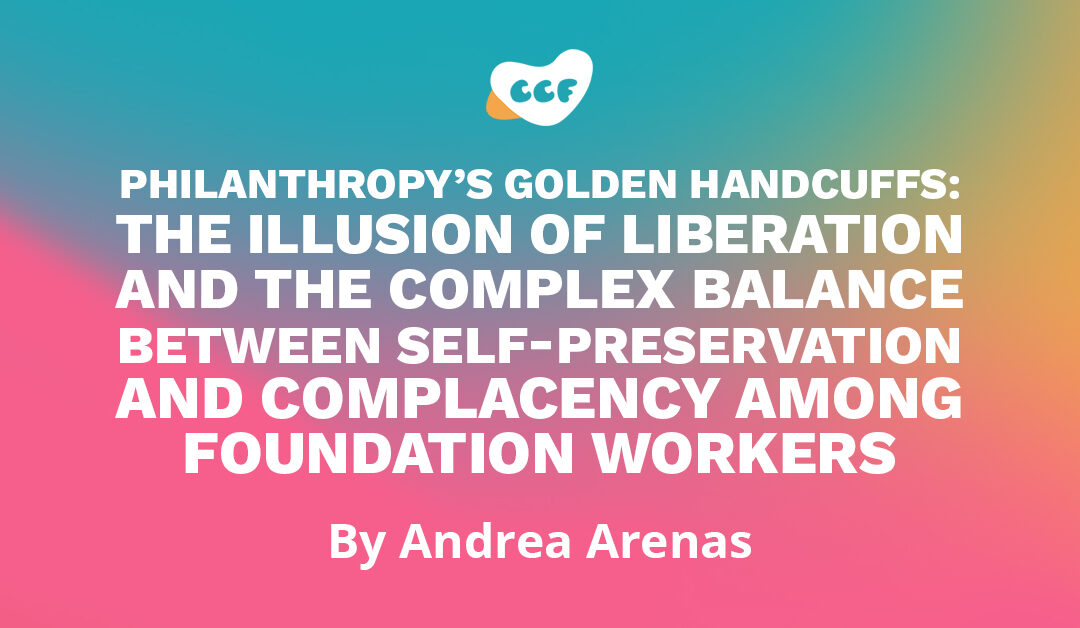By Andrea Arenas, Co-founder of CCF, advocate for more equitable philanthropy
In my pursuit of contributing to more equitable grantmaking practices, it became apparent that my initial honeymoon period, which boasted an abundance mindset and work-life balance, was really the cuffing of philanthropy’s golden handcuffs.
When I made the decision to transition from my fundraising job to philanthropy, I had a clear purpose in mind. Recognizing the immense power held by funders and their potential to reshape the sector to be more equitable, I was eager to be part of that transformation.
However, my journey within philanthropy took an unexpected turn when I found myself wearing golden handcuffs and ultimately being fired.
The concept of “wearing golden handcuffs” refers to individuals who feel trapped in their jobs due to attractive salaries and benefits, even if they may feel unfulfilled, denied professional growth opportunities, or restricted in their actions and expressions. Financial incentives and fringe benefits create a sense of dependency that can hinder employees’ ability to challenge the status quo, often leading to emotional conflict for the individual or fostering a culture of complacency within the organization.
In my pursuit of contributing to more equitable grantmaking practices, it became apparent that my initial honeymoon period, which boasted an abundance mindset and work-life balance, was really the cuffing of philanthropy’s golden handcuffs. I wrestled with the allure of having a high-paying job with shiny benefits with the desire to translate CCF principles into philanthropy.
In hindsight, I now realize that my golden handcuffs would tighten each time I attempted to challenge the status quo until they finally unhinged during my unanticipated termination.
Applying the Notion of Golden Handcuffs to Philanthropy
We’ve all seen those enticing, yet elusive, philanthropy job postings with fat paychecks and oodles of perks. They might seem like a dream come true, promising comprehensive health insurance, an annual professional development budget, a family leave program, a retirement fund with generous employer match, and often a wellness stipend. For fundraisers entering philanthropy, going from the nonprofit scarcity mindset – where we’re excited to eat the leftovers from donor events – to actually having money, time, and employer encouragement – where you treat yourself to a monthly massage – feels like entering paradise. But this scenario can actually trap us in a cycle of dependency, making it hard to break free and push the sector towards more equitable pathways.
Additionally, philanthropy jobs often put us in close proximity to power. This proximity and positionality to uber-wealthy privilege can be an entirely new experience for a lot of us, especially people of color and folks from marginalized communities. We enter the philanthropy sector fired up with radical ideas of liberation and a fierce determination to dismantle the oppressive structures of white supremacy culture.
Cue the golden handcuffs…
The golden handcuffs not only impact individuals but also hinder progress within the sector as a whole. When those in positions of power and influence become complacent, unwilling to challenge the status quo, or silenced by their fear of losing benefits, the sector’s potential for innovative and transformative change is severely limited.
The power of the golden handcuffs is actualized when philanthropy staff lean into the rewards of complacency.
Consequences of Revolting Against the Handcuffs
People of color may find their golden handcuffs feel tighter than those of their white colleagues. They often face harsher repercussions when speaking out against injustices within the sector. The fear of losing their jobs, financial security, and benefits can be much more profound. Characteristics of white supremacy culture, such as tone policing, perfectionism, and the right to comfort, add layers to the complexity of how tight or loose your metaphorical handcuffs may feel.
Acknowledging these dynamics is essential for understanding the internal disparities within the white-dominated ethos of philanthropy.
In my own experience, I decided not to soften my language to be more palatable for white fragility, prioritizing my values over the restrictions of my handcuffs. I chose not to compromise my integrity, and to challenge the systems of oppression I thought I was hired to help dismantle.
And yes, it led to my termination.
My decision to revolt against the handcuffs was my own, and it’s not going to be the right choice for everyone. In some cases, self-preservation via self-care, creating intergenerational wealth, and maintaining mental health and a sense of security is the long game in combating oppression.
Self-Reflection Questions
It’s important to remember that breaking free from the golden handcuffs is a process that requires self-compassion and patience, and the acknowledgment that pushing too hard can lead to extremes like getting fired and feeling ousted.
Here are seven questions to consider as you assess the tightness or looseness of your own golden handcuffs:
- How does my financial reliance on my job impact my willingness to take risks and speak out against injustice?
- What specific benefits keep me tied to my current position, and how do they sway my decision-making?
- Am I compromising my values and beliefs to the point where it undermines my commitment to social justice?
- What fears or consequences do I associate with rocking the boat and challenging the status quo?
- In what ways does capitalism drive individualism within the sector, and how does it affect my ability to advocate for collective liberation?
- What strategies can I implement to maintain my authenticity, even within the confines of the golden handcuffs?
- How can I actively seek support and build relationships with colleagues who are values-aligned so that together we can push against the constraints of the golden handcuffs?
Breaking Free and Advancing Justice
While the decision to revolt against the golden handcuffs is deeply personal, we can seek out allies and build relationships with like-minded individuals in the sector. These trusted colleagues can serve as sources of support and encouragement, helping us combat complacency, fostering accountability, supporting us when we lean into risk, and risking their own benefits when the consequence feels too great for us.
It’s important to remember that breaking free from the golden handcuffs is a process that requires self-compassion and patience, and the acknowledgment that pushing too hard can lead to extremes like getting fired and feeling ousted. Maintaining a moral compass and pursuing systemic change is challenging, as the system is designed to prevent us from attaining this. In philanthropy, white supremacy culture’s biggest misdirect is the false sense of security that the golden handcuffs bring.
Let’s be real with ourselves by acknowledging the fears and obstacles we face, and recognizing how tight or loose our golden handcuffs fit. The only way to combat complacency is to recognize when it’s sneaking into our work and by identifying at what cost.

Andrea Arenas
Andrea Arenas (she/her) is dedicated to reimagining the world of fundraising and philanthropy through community-driven approaches. She is the founding Co-Chair of Community-Centric Fundraising, and with over 17 years of nonprofit experience she recently began her own fundraising and philanthropy consulting business. She’s a proud mama and when she’s not conspiring with others to shift the sector, she’s playing in the mud, collecting rocks, and tide pooling with her son.
You can find Andrea at andrea-arenas.com and on LinkedIn — and tip her on Venmo.
Discover more from CCF
Subscribe to get the latest posts sent to your email.


Fantastic work of self- reflection, Andrea.
Thanks for sharing your experience. Many people of color get easily co-opted by the shinning power that comes by being proximate to wealthy people. It takes courage to remain true to yourself.
Andrea, this is a powerful message of what resistance looks and feels like in the philanthropic sector. Few admit it as openly as you have and could benefit from a closer look at how much of their well-being is being compromised and destroyed. Keep walkin’ the talk!
Andrea, you are amazing! Your reflections on this situation are poignant and productive, and I hope they’ll contribute to much-needed change in philanthropy culture and practice. Thanks for speaking up.